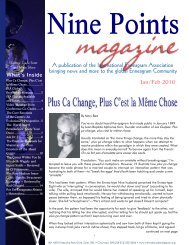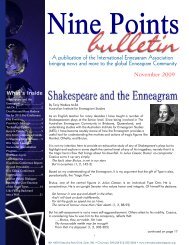Nine Points Magazine - International Enneagram Association
Nine Points Magazine - International Enneagram Association
Nine Points Magazine - International Enneagram Association
Create successful ePaper yourself
Turn your PDF publications into a flip-book with our unique Google optimized e-Paper software.
I can’t hurt, upset or inconvenience anyone or I’m bad and<br />
unlovable.<br />
As Mary learns to ask for help, she notices that the<br />
help she receives, be it attention, compassion, or<br />
loving suggestions, makes her feel selfish, which<br />
she can’t bear for very long. “I feel so selfish when I<br />
receive anything. Like I’m a greedy person. I should<br />
be helping instead of asking for help! I see what he<br />
needs, why shouldn’t I help?!” I gently remind her<br />
that she is two weeks sober and her life in<br />
desperate straits. She begins to see that in the same<br />
breath that she receives help, she immediately starts<br />
planning how to help her boyfriend, when she is<br />
only barely surviving herself. This mechanism is fast<br />
and swift, mostly invisible to Mary, but with many<br />
patient reminders she will begin to see the<br />
mechanism at work and the underlying feelings<br />
driving the habit: her conviction that she is not<br />
lovable or wanted. It first arises as a compelling<br />
need to help another and to avoid the feelings of<br />
being selfish, and with time she will feel the core<br />
issue: I am unlovable and unwanted. The quick turn<br />
of attention to her boyfriend diverts the harsh sting<br />
of feeling selfish or unlovable. This habit has been<br />
her survival for enduring intractable suffering in her<br />
life.<br />
See if you can grasp the prison she is in. “There is no love<br />
so I must create it. I’m not really wanted so I must make<br />
myself indispensable. I’m bad if others get mad at me,<br />
don’t love me, or don’t want to be with me. I can’t sense my<br />
needs because I only see yours, which means I can’t<br />
experience lasting happiness or peace unless you are happy<br />
with me. I’m on empty all the time trying to fill myself with<br />
you. I can’t love others enough to get rid of the nagging<br />
feeling I’m not wanted.” This is the machine that runs her<br />
addiction to drugs, or to people.<br />
The belief and feeling that “I’m not loved, there is no love, I<br />
must produce the love” will be there throughout her<br />
recovery. It will be touched over and over again at deeper<br />
levels. It may arise after moments of great love and joy, or<br />
at the end of a romantic relationship. But arise it will.<br />
As Mary continues her treatment, her<br />
boyfriend breaks up with her. In less<br />
than a week she has found another<br />
‘love,’ someone she cares<br />
about. Like a homing pigeon she has<br />
found a temporary home in another<br />
needy soul. As she learns to observe<br />
this process with compassion she will<br />
slowly sense the suffering of her basic<br />
13<br />
fear: being without love. As she learns to bear this<br />
feeling rather than transform it into another action<br />
of fear-driven kindness towards another, she will<br />
begin grief work, sensing into the wound that<br />
caused this mechanism. In time, through her tender<br />
grieving will arise the palpable sense of her own<br />
lovingness, her True Nature. This will begin her<br />
redemptive journey, sensing within her the love that<br />
she so longs for. But the habit of forgetting herself<br />
and tuning into others will not disappear quickly.<br />
When she thinks she’s finally understood it she will<br />
discover another layer still operating. With kindness<br />
and grace she will observe the speed of this<br />
mechanism, her tendency to try to love someone<br />
who cannot love her back, her need to redouble her<br />
efforts to save the wounded lover, with addiction<br />
calling to her at her most vulnerable moments. If<br />
she is aware of these Type Two patterns, develops<br />
eyes to see them, learns the Siren Call of these<br />
patterns, she will sit in the suffering, allow others to<br />
support her, digesting it such that the quality of her<br />
lovingness and sweetness begins to emerge and<br />
make its presence known. As she loves with less<br />
fear, she will love more deeply, and she will find<br />
those who can return her love. This is the adventure<br />
she has embarked upon, the redemption of her<br />
heart.<br />
Here’s the untold story that recovery circles have yet to<br />
grasp: the healthier she gets, the more she will<br />
by her personality habits, the more sharply and clearly she<br />
will begin to sense her deepest fear of being unlovable and<br />
unwanted. At year 5, 10, 15, 20 or 25 of her recovery, after<br />
much growth, she may feel it head-on and it will bring her<br />
to her knees. If she knows this in advance, she will get the<br />
help she needs and move through it. If she has no<br />
knowledge of this dynamic, she may feel that all her efforts<br />
were for nothing, that she has failed at what she cares about<br />
most. How could she be feeling so badly after all the work<br />
she’s put in over fifteen years of addiction recovery? In<br />
despair, she may relapse or develop a new addiction, or<br />
suicide.<br />
But being forewarned in understanding<br />
the stages of true spiritual growth as<br />
Riso/Hudson have so clearly described in<br />
, she will<br />
get the support she needs. The myth that<br />
sets many wonderful recovering folks up<br />
for the heart-rending return to addiction is<br />
that after a year or two, or ten, or fifteen<br />
of sobriety, their major suffering will have





